‘I love to have crazy ideas.’ This is the key motto of Lee Cronin, chemist at the University of Glasgow in Scotland, and it underpins his approach to research.
An inorganic chemist by training, Cronin holds no qualms in charging across boundaries to wherever his ideas take him. ‘He is a polymath,’ says Fraser Stoddart of Northwestern University in the US. ‘He’s not just a chemist. He is a chemical engineer, material scientist, biological chemist, modeller, synthetic biologist. Lee is into robots and artificial intelligence and 3D printing. He is a scientist of these contemporary times.’
Aged 42, he has built a 50-strong group in Glasgow to assist him, received over £15 million in funding, and published over 320 papers. The group began with a focus on inorganic metal oxide clusters (polyoxometalates or POMs), and still does, but Cronin bounds with enthusiasm for two big challenges.
Maybe I’m the one person who can digitise chemistry. I know enough synthetic chemistry and enough computing to put the two of them together
How does chemistry turn into biology? Cronin is emphatic that this is not a simply historical question of what happened, and argues for new experiments. He aims to make new artificial life in his lab, using different building blocks than life on earth. ‘They would be orthogonal, a new shadow biology,’ he explains.
His lab is trying to understand and control self-assembly and self-organisation in large molecules. ‘Everyone is arguing about their version of events [in the origin of life], but it would be more engaging if we could come up with a problem that was testable in real time,’ he says. ‘Let’s have a competition to see who can make the simplest thing that can get more complicated.’
Secondly, Cronin wrestles with how to build chemical control systems and digitise chemistry. His ambition: to make and discover molecules using algorithms and robots, shifting synthetic chemistry away from being a bespoke, artisan discipline. ‘Chemistry is not universally reproducible. I would like to develop a framework that allows me to discover a new molecule in my lab today and ensure tomorrow you could make it.’
Cronin is working on self-assembly of molecular metal oxides in flow reaction arrays, robotics and 3D printing to run chemistry experiments, solar water splitting, memory devices and new smart reactors for evolvable chemistry and artificial intelligence. He is fervent about his lab’s present effort to evolve molecules into superior antibiotics.
‘His approach is to be thinking on a grand scale and he is fired up most of the time that I interact with him. He is missionary in his zeal,’ Stoddart observes. Cronin arrived in Glasgow in 2002. ‘It’s a department with a very rich history, going back to Joseph Black and the Scottish enlightenment. One could almost say Lee has brought that enlightenment back to Glasgow,’ says Stoddart.
Early days
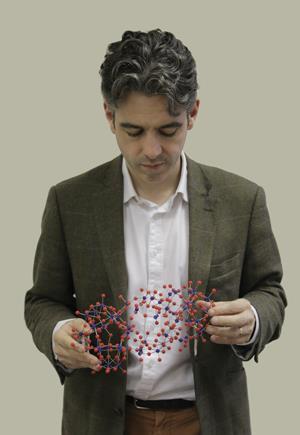
Becoming a high-flier seemed an unlikely path for the young Cronin while growing up in his native Ipswich in Suffolk, England. His parents divorced when he was nine and two years later he was slotted into a learning difficulties group in primary school and then in high school, with lots of dysfunctional students. ‘I felt really isolated,’ Cronin recalls. ‘I loved learning, loved asking questions, but it seemed the teachers had pigeon-holed me.’ He didn’t feel he had learning difficulties and tried to convince his teachers. In the end, with parental intervention, he was allowed to sit his GCSE exams.
Teachers had rebuffed his talk of macrocyclic chemistry, but he had begun to read chemistry books while in primary and secondary school. His life transformed after the exams, when he moved out of the remedial class. At 16, he tried to set up a carbon dioxide laser in his shed, but couldn’t get the vacuum right; he had more success with a wind tunnel. Cronin engrossed himself in undergraduate chemistry at the University of York in the UK, becoming intrigued by complex systems, self-organising chemistry and oscillating reactions. He considered maths, physics and computing, but decided that ‘all of the interesting questions were in chemistry’. His doctorate at York with Paul Walton focused on making small ligands and metal complexes, trying to build functional models for metallo-enzymes, and he became immersed in synthesis and coordination chemistry. During his DPhil, he met his future wife Debbie at a crystallography course in Durham, UK.
At a 1997 conference in Copenhagen, Denmark, Cronin met Achim Müller, who described POMs as almost life-like in complexity. Although he didn’t have a PhD at this point, Cronin went around the conference terrorising senior professors, telling them where their research was going wrong, recalls Richard Winpenny, now at the University of Manchester, UK. Cronin went on to the University of Edinburgh in the UK as a research fellow, where he worked on electronic ion sensors, discovered some new macrocycles and became friends with Winpenny. ‘He was incredibly intense,’ says Winpenny. ‘He drove everybody to distraction by constantly suggesting other ways of doing everything. Some of us eventually realised that this was someone who was overflowing with ideas and had little control over what he said.’
You learn a lot working with Lee because he has such varied interests. He has huge energy and he knows what everyone in his group is doing
Richard Winpenny
While some labmates bristled, Winpenny found him hugely entertaining. ‘I realised there was a monumental intelligence at work behind this curious behaviour,’ he says. Cronin combines tremendous self-belief with an ability to take robust, even scathing criticism, a point repeated by numerous collaborators. He is now a little more measured, but still brims with ideas and future plans. And Cronin says criticisms have helped him. He has time for anyone who criticises his research and will readily criticise the great and good himself. ‘Not a very English trait,’ he quips. After Edinburgh, he took a von Humboldt research fellowship and joined Müller’s group in 1999 at the University of Bielefield in Germany, which was constructing massive, complex molybdenum structures.
‘They were making gigantic nanostructures, from the bottom up, no lithography, no template. Just take sodium molybdenum salts plus electrons, plus reducing agents, add some acids, and you make a 154-atom molybdenum wheel with 500 oxygen atoms. That just blew me away.’ He moved back to the UK as a lecturer at Birmingham University in 2000, gripped by a fascination with POMs. At Birmingham, Cronin began by designing smaller POM clusters. He moved to Glasgow in the summer of 2002.
In Glasgow
POMs are relatively easy to make – take a metal salt and change the counter ion and the pH of the solution. ‘We made some breakthroughs in self-assembly of small clusters and that enabled me to get nice papers and my initial funding,’ says Cronin. For example, he isolated a mixed-valence polyoxomolybdate cluster via a ‘shrink-wrapping’ approach to trap clusters with low symmetry. ‘It had an embarrassing front piece [in the journal], a mouse trap, but that’s what we did. We isolated an intermediate.’
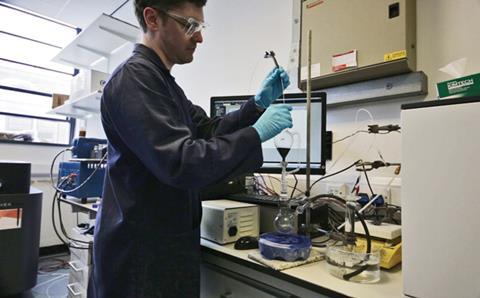
With careful control, he can generate metal oxide clusters with defined sizes, say 12 or 18 metal atoms. These metal–oxygen clusters often show topological and electronic versatility and highly symmetric core assemblies of vanadium, molybdenum or tungsten oxide. POM clusters are usually anionic and can be complexed with cations as links. They can have interesting colours, are reduced easily and catalyse reactions with all sorts of interesting substrates, explains Mark Symes, a colleague at the University of Glasgow. ‘They have interesting magnetic properties as well, and by substituting different metals here or there, you can get beautiful structures and a range of functions too.’
Symes worked in, and now works with, Cronin’s lab using POMs for solar fuel cells. POMs are very stable and Cronin and Symes’ groups used them to create an electron-coupled proton buffer. The POMs were used to split water in two steps – one electrochemical and one catalytic – separating oxygen from hydrogen evolution in time and space.
‘You learn a lot working with Lee because he has such varied interests,’ says Symes. ‘He has huge energy and he knows what everyone in his group is doing, even though there are 50.’ Cronin meets everyone in his group almost every week, which is organised into POM, complexity, origin and robot subgroups. There are group meetings every month looking at team projects, as well as others on individual progress.
His approach pays dividends. In 2007, he won the Philip Leverhulme Prize. ‘That was really important. It was flexible and I was able to employ another student on an important project,’ says Cronin. ‘But the award that changed everything was the EPSRC Advanced Fellowship [2005], a five-year fellowship to pursue my dreams.’ Publication output cranked up. He confined electron transfer reactions in molecular cages, and observed molecular self-assembly with mass spectrometry.
‘His publications started to take the world by storm around 2008, 2009 onwards. You start to see high profile papers and there was a 2009 Nature Chemistry paper that caught the eye. It was on the front cover. It has been an upward trajectory since then,’ says Stoddart, who sees similarities with his colleague Chad Mirkin at Northwestern. Cronin then designed a flow reactor system to reveal how a central {Mo36} cluster templated the assembly of a surrounding {Mo150} wheel; adding in the template accelerated assembly time and boosted the yield.
Hitting his stride
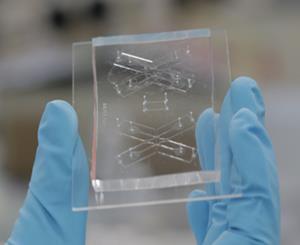
Cronin went on to develop methods to use 3D printing, creating chemical reactors, microfluidics and even ‘reactionware’ (where the labware was impregnated with reagents). Surprises kept flowing: POM-based flash memory devices and crystal gardens, robotically mediated chemical evolution and a new way to synthesise inorganic–peptide hybrids. He has guided chemical reactions in real-time using NMR and reported how to programme peptide synthesis.
Cronin is renowned for punishing work hours. He does office hours around 9 to 5, goes home to his wife and young sons in the evening and writes grants, papers and emails from 8pm to 4am, says Symes. ‘I’m fairly sure he sleeps between three and four hours a night.’ He has over a hundred collaborators, including Paul Kögerler at the University of Aachen in Germany, Hiroki Oshio at the University of Tsukuba in Japan, and Alexei Lapkin at the University of Cambridge, UK. ‘His broad interests mean that if he goes to a lecture, it could be a completely different field of chemistry than he’s in, but he will find it enjoyable, ask questions and build bridges,’ Symes adds. Lapkin met Lee around 2002 on a workshop to bring chemist and chemical engineers together in a speed-dating format. They hit it off and joined forces to design smaller, more efficient flow reactors. Cronin believes in building collaborations on a bedrock of mutual need and readily opens up his ‘pantry of molecules’.
‘He picked up quickly how to do reactions under flow conditions,’ says Lapkin. ‘He has since pushed capabilities of flow reactions, in a way that’s interesting to chemical engineers.’ Mixing in flasks is an old-fashioned way to do chemistry, while making molecules under flow allows you turn space into time, better control conditions and set up analytics along a time gradient. ‘Once you have analytics at the end, as Lee has shown, you can make unexpected materials and rapidly create libraries of materials.’ The two are now collaborating on intelligent algorithms to design experiments, controlling them through automation, in carefully designed reaction chambers.
Future plans
On the floor below Cronin’s office, his lab hums with robots at work, as webcams record experiments and 3D printers crank out new reaction chambers tailored for specific experiments into self-organising molecules. Cronin is a self-declared digital nut, who has been programming ever since his father gave him a Sinclair ZX81, with a 16kB RAM pack. He connected to the Internet before HTML was created. ‘Maybe I’m the one person who can digitise chemistry. I know enough synthetic chemistry and enough computing to put the two of them together,’ Cronin says matter-of-factly.
There is no barrier between me and students in my lab. I care about my people’s time
In 2015, he set up Cronin Group plc to make chemistry easier, cheaper, more reproducible and more universal, using robotics and digitisation to assist drug discovery, for instance. That’s the plan. He also wants chemists to join a worldwide collaborative quest to search for new biology and make artificial lifeforms, in a way physicists have done to answer their big questions. ‘I’m trying to convince organic chemists to stop being so self-obsessed. To stop just making molecules, as if they are the answer to life,’ he says. Chemistry giving rise to a process that gives rise to life is the wrong way round – there must be a privileged process that selects chemistry to make biology, but process comes first. Life had to be inorganic initially, it need not have taken a long time and it had to build itself, he explains. He is exploring with Nasa the concept of ‘minimum complexity’ as a detector for alien biology.
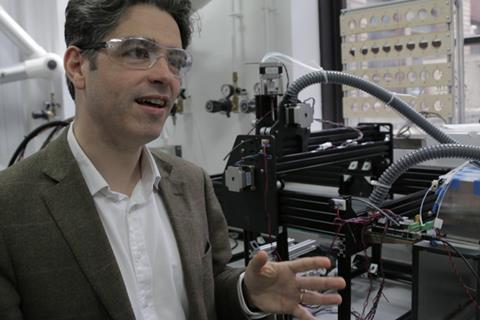
‘I’m an explorer. I love the unknown,’ says Cronin. It can be almost hard for him to discuss past experiments; future ideas are front and centre. Stoddart says detractors scoff or dismiss Cronin’s big ideas, but chemists need to be tackling big problems like emergence, non-equilibrium systems and the origin of life. ‘Lee has blown chemistry out of its boxes. Even 30 years ago it was inappropriate to talk about organic, inorganic, physical, theoretical chemistry. It’s been counterproductive and nonsensical to stay as narrow specialists.’
Cronin also has a reputation for being supportive of his research postdocs and students. ‘There is no barrier between me and students in my lab. There is an organisation for administrative purposes. I’m a limited resource and not particularly coherent most of the time,’ he says. He aims to inspire people, but not scare them into working too many hours. ‘I care about my people’s time. They haven’t got much time for a PhD, or to make a discovery. My wife goes crazy, because most of the time I value everyone else’s time more than mine. And I do get knackered.’
People tend to stick around. ‘He tends to view you as an asset and encourage you to stay. You feel valued,’ according to one of his newest PhD students, Naomi Johnson. Winpenny sums him up: ‘Lee is actually more interesting when he is wrong than most people are when they are right.’
Anthony King is a science writer based in Dublin, Ireland
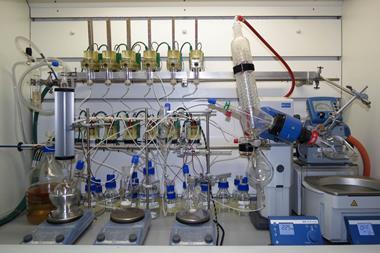


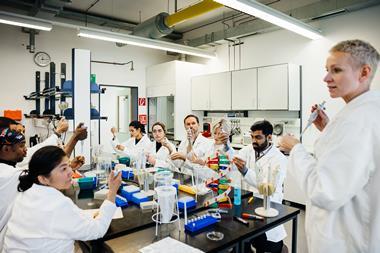

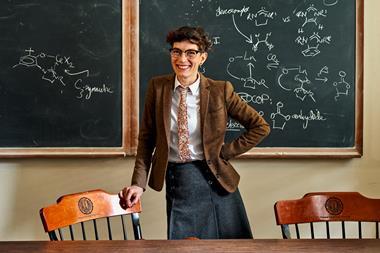

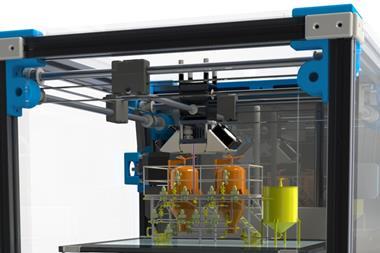












No comments yet